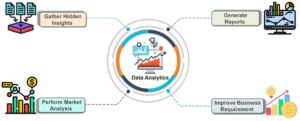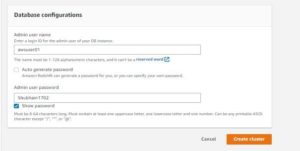AWS Solution Architect Certification Training
- 183k Enrolled Learners
- Weekend/Weekday
- Live Class
In today’s digital era, businesses operate in a data-driven environment where data is generated at an unprecedented rate. Every single activity of our daily life is influenced by connected existence and nowadays all these activities include technology. This is where AWS Data Analytics comes into action, providing businesses with a robust, cloud-based data platform to manage, integrate, and analyze their data.
In this blog, we’ll explore the world of Cloud Data Analytics and a real-life application of AWS Data Analytics.
Here are the topics that will be covered:
The following statistics gives an overview of the amount of data that is shared across the globe every day.
More than 50 million pieces of content are shared every day. More than 1 billion websites are online. More than 500 million Tweets are sent every day. More than 50 billion pieces of content are shared on Facebook each month.
As of January 2023, there were 5.16 billion internet users worldwide, which is 64.4 percent of the global population. Of this total, 4.76 billion, or 59.4 percent of the world’s population, were social media users.

The total amount of data created, captured, copied, and consumed globally is forecast to increase rapidly, reaching 64.2 zettabytes in 2020. Over the next five years up to 2025, global data creation is projected to grow to more than 180 zettabytes. Majority of these data is stored in the cloud.

(image source : https://www.statista.com/statistics/871513/worldwide-data-created/)
Presence of Data Analytics in Your Life
The amount of data being generated and gathered is expanding and accelerating substantially as society becomes more digital. As a result, it becomes difficult to analyze this constantly expanding data using conventional analytical tools. This is where Data Analytics comes into action.
Data Analytics tools and technologies offer opportunities and challenges for analyzing data efficiently so you can better understand customer preferences, gain a competitive advantage in the marketplace, and grow your business.
Data analytics is the process of converting raw data into actionable insights. It encompasses a variety of tools, technologies, and procedures that utilize data to identify patterns and solve issues. Data analytics can influence business processes, enhance decision-making, and promote business expansion.
Data Analytics has a key role in improving your business as it is used to gather hidden insights, generate reports, perform market analysis, and improve business requirements.

How can the Cloud Help?
The number of IoT-connected gadgets in our daily lives is rapidly expanding.

Businesses today rely heavily on cloud data analytics to help them deal with the difficulty of keeping up with the current rate of data generation, utilization, and storage. Cloud data analytics can help firms make better decisions by following data patterns and eliminating the need for assumptions. Taking into account all of the cloud’s possibilities as well as the possible risks, organizations are increasingly adopting cloud for its many benefits, with data being one of the most crucial decision considerations.
The objective is to ensure that data can be processed and analyzed more quickly with the assistance of cloud experts. Cloud offers access to various services like servers, data analytics, Artificial Intelligence, Machine Learning and much more. It provides an advanced features to process and analyze the huge amount of data in a day to day world.
Cloud technology can be used to build entire data lakes, data warehousing, and data analytics solutions.

Without spending a lot of money on hardware, it is possible to acquire virtual machines and install software to manage data replication, distributed file systems, and entire big data ecosystems.
Many cloud providers, including Amazon Web Services, began to observe that customers were deploying virtual machines to implement big data tools and frameworks. And then based on this observation, Amazon began to develop offerings with everything installed, configured, and ready to use services such as Amazon EMR, Amazon S3, Amazon RDS, Amazon Athena, and many others.
Another significant advantage of cloud-based data analytics is the ability to cease paying for infrastructure resources when they are no longer required. This happens often in data analytics since running reports on huge data processes is done once in a while. And in the cloud, you can accomplish so simply by launching a server or other service, utilizing it to get the necessary report, storing it, and then shutting down all of the other services.
Amazon Web Services (AWS) offers a comprehensive platform of managed services to facilitate the development, security, and scalability of end-to-end big data applications. AWS offers the infrastructure and resources to take on your next big data project, whether your applications need real-time streaming or batch data processing.

One can also go for the AWS Data Engineer Certification program and get certified.
AWS provides thorough, safe, scalable, and economical data analytics services. AWS provides services for data transfer, data storage, data lakes, big data analytics, machine learning, and everything in between that are specifically designed to deliver the greatest price-performance.
Some of the most popular AWS Data Analytics Services are:

Amazon Redshift is a rapid, fully managed, petabyte-scale data warehouse service that makes it easy and affordable to analyze all of your data using your existing business intelligence tools. It is optimized for datasets ranging from a few hundred gigabytes to a petabyte or more and costs less than $1,000 per terabyte per year, a tenth the cost of most traditional data warehousing solutions.
Amazon Redshift uses SQL to analyze structured and semi-structured data across data warehouses, operational databases, and data lakes, using AWS-designed hardware and machine learning to deliver the best price performance at any scale.


Step 1: Create a file (data.txt) with the below content. Feel free to add more rows to the data. The different attributes in the data set are year, month, date, actual departure time, scheduled departure time, origin, and destination airports in the same order. From this data, we would be interested in figuring out the best and the worst airports based on the number of flights getting delayed.
2020,1,21,1300,1100,CHI,OHR2020,5,11,1100,1100,CHI,OHR2020,6,8,1500,1500,NY,DAL2020,7,17,1600,1300,NY,DAL2020,3,16,1530,1520,NY,OHR2020,4,15,1600,1545,NY,OHR
Step 2: Create a bucket in S3 and upload the data.txt file to it.

Step 3: Go to the IAM Management Console and click on Roles.
 Step 4: Select Redshift as the service which is going to use this role, click on Redshift – Customizable and click on Next: Permissions.
Step 4: Select Redshift as the service which is going to use this role, click on Redshift – Customizable and click on Next: Permissions.

Step 5: Select AmazonS3ReadOnlyAccess Policy from the list and click on Next.

Step 6: Enter the role name as Role4RedShift-S3RO and click on Create role.



Step 7: Click on the Role and note down the Role ARN to be used along with Redshift later.

Step 8: Go to the Redshift Management Console and click on Create cluster.

Step 9: Give the cluster a name. Select dc2.large as this fall under the free trial Node type.

Step 10: Select the number of nodes as 1, again as this fall under the free trial Number of Nodes.

Step 11: Give the username and password, make sure to note it down.


Step 12: Under the Cluster permissions,” select the IAM Role created in the previous steps and click on Add IAM role.

Step 13: The rest of the default options are good enough. Try to explore the different options and click on Create cluster.

Step 14: Initially, the Redshift cluster would be in a creating status. Click on Cluster.

Step 15: Finally, the cluster would be in available status and is ready for the queries to be run in a few minutes.

Step 16: Click on the Editor tab in the left pane. Select the Cluster, enter the Database name as dev, and finally the user and password. Click on Connect to database.

Step 17: In the Query tab, paste the below query and click on Run to create the onetime table.
create table ontime ( Year integer, Month integer, DayofMonth integer, DepTime integer, CRSDepTime integer, Origin varchar(120), Dest varchar(120));

Step 18: Now, the table must be populated with the data. Again, in the same Query tab, copy the below command and click on Run. Make sure to change the bucket name and the IAM Role ARN. In a few seconds, the data in the table will be populated. In the Query results, it should indicate the status Completed.
copy ontimefrom 's3://airline-details-01/data.txt' iam_role 'arn:aws:iam::910563908074:role/Role4RedShift-S3RO' delimiter ',' region 'us-west-2';

Step 19: In the same Query tab, execute the below query to see if the data is populated.
select * from onetime;

Step 20: Execute the below query to get the number of flights delayed from each of the origin. This will give the best and the worst airports based on the number of flights getting delayed.
select Origin, count(*) as Count from ontime where DepTime > CRSDepTime group by Origin order by Count desc;

Large hospital systems use analytic services to integrate and analyze data from various sources, including electronic health records, claims data, and pharmacy data. AWS Data Analytics services can play an important role in quickly querying and analyzing large volumes of data and identify patterns and trends that lead to improved patient outcomes.

Large retailers use analytic services to integrate and analyze data from various sources, including point-of-sale data, website data, and customer data. By leveraging AWS Data Analytics Services, they are able to create real-time dashboards and reports that provide insights into customer behavior, sales trends, and inventory management.
A large financial services firm use analytic services to integrate and analyze data from various sources, including customer data, financial market data, and internal data. AWS Data Analytics play an important role in ensuring the confidentiality and integrity of sensitive financial data while providing real-time analytics and insights to their traders and analysts.
1. General Electric (GE) improved how customers browse, find and source data


Nasdaq is a multinational financial services and technology corporation that owns and operates the Nasdaq Stock Exchange. Nasdaq operates a total of 27 markets, a central securities depository, and clearinghouse across a variety of asset classes in North America and Europe. Nasdaq moved from a legacy on-premises data warehouse to an Amazon Web Services (AWS) data warehouse powered by an Amazon Redshift cluster. Between 2014 and 2018, this Amazon Redshift cluster grew to 70 nodes as the company expanded the solution to support all its North American markets. By 2018, the solution ingested financial market data from thousands of sources nightly, ranging from 30 billion to 55 billion records and surpassing 4 terabytes.
 Magellan Rx Management (Magellan Rx), a division of Magellan Health Inc., is a next-generation pharmacy organization that delivers meaningful solutions to the people it serves. The organization hosts its data using Amazon Redshift, a fully managed petabyte-scale data warehouse service in the cloud that enables users to query and combine exabytes of structured and semistructured data across data warehouses, operational databases, and data lakes using standard structured query language (SQL). Using AWS services, Magellan Rx reduced operational costs, shortened extract, transform, and load (ETL) times, and scaled operations.
Magellan Rx Management (Magellan Rx), a division of Magellan Health Inc., is a next-generation pharmacy organization that delivers meaningful solutions to the people it serves. The organization hosts its data using Amazon Redshift, a fully managed petabyte-scale data warehouse service in the cloud that enables users to query and combine exabytes of structured and semistructured data across data warehouses, operational databases, and data lakes using standard structured query language (SQL). Using AWS services, Magellan Rx reduced operational costs, shortened extract, transform, and load (ETL) times, and scaled operations.

Zynga is the developer of some of the world’s most popular social games, including Words with Friends, Zynga Poker, and Farmville, which are played by more than 70 million users around the world every month. Zynga’s mission is to connect the world through games, and the company holds analytics as a central component of its culture in order to achieve that mission. By migrating its data warehouse to Amazon Redshift, Zynga doubled extract, transform, and load (ETL) performance, easily scales to process over 5.3 TB of game data generated each day, and can conduct long-term analysis and experiments to better understand and optimize the player experience.
Data analysis requires scalable, adaptable, and high-performance tools to quickly provide insights as data volumes grow. However, organizations face challenges in the ever-expanding big data landscape where new tools quickly become outdated. Selecting the right tools can be daunting. AWS offers a range of options to address big data analysis requirements. Building a comprehensive solution typically involves leveraging multiple AWS products. This approach helps organizations meet critical business needs while ensuring cost-effectiveness, performance, and resilience. Consequently, organizations gain the advantages of a scalable big data infrastructure.
Check out our AWS Certification Training in Top Cities
| India | Other Countries/Cities |
| Hyderabad | Atlanta |
| Bangalore | Canada |
| Chennai | Dubai |
| Mumbai | London |
| Pune | UK |
If you want to explore more about AWS Data Analytics, consider taking an AWS Solutions Architect Certification Training Course with a reputable provider such as Edureka. With Edureka, you can learn from industry experts and gain hands-on experience working with real-world projects.
 Thank you for registering Join Edureka Meetup community for 100+ Free Webinars each month JOIN MEETUP GROUP
Thank you for registering Join Edureka Meetup community for 100+ Free Webinars each month JOIN MEETUP GROUPedureka.co